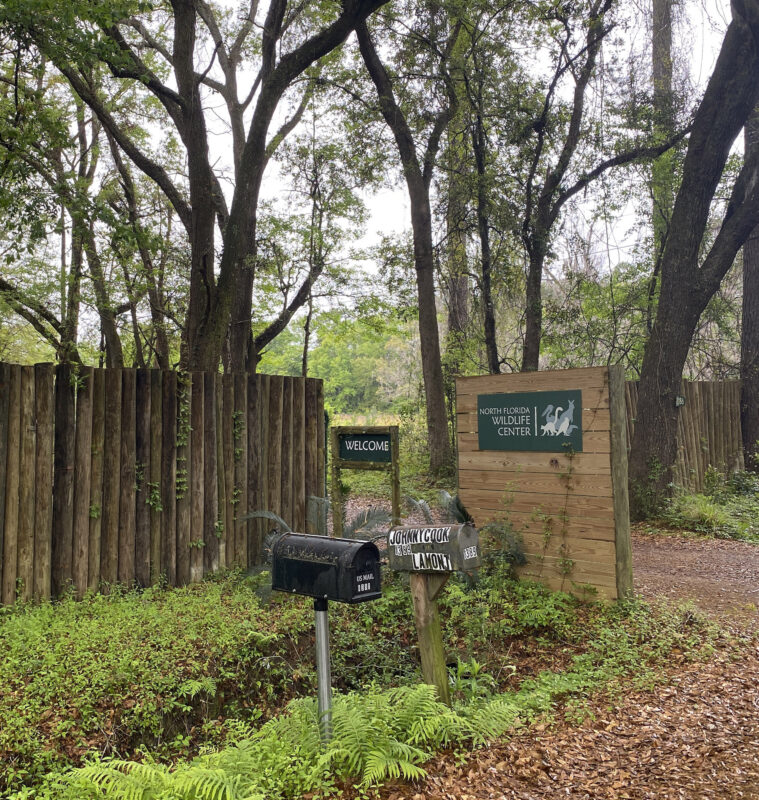By Pat Foster-Turley

In preparation for yet again another road trip to Florida’s Big Bend Area I did some extensive Google Map searching to find some place Bucko and I had not yet visited. And I found the North Florida Wildlife Center to the east of Tallahassee. Perfect! What is this place anyway? I was determined to find out.
The previous day (and previous column), we visited the Gulf Specimen Marine Lab while Joel Sartore, famed National Geographic photographer, was shooting specimens there. And, lo and behold, the previous day, Joel had also visited the North Florida Wildlife Center (NFWC) to photograph some rare hornbill bird species. As with the Gulf Marine Lab, Joel has been here before, too. Who would have guessed?

At the NFWC, by advance arrangements, we were met by director Ryan David Reines, who showed us around and explained their mission. As a former zoo director of education myself I well understood their intent: to enable people to get closer looks and interactions with rare and endangered species that need much more public attention to save their wild populations and habitats. By forming a personal connection with these animals, it is hoped that donations to their wild causes will be stimulated to help in conservation programs. NFWC seems to be a labor of love, in its initial stages since its founding just a few years ago.
When Ryan toured us around, we saw a Florida State University student keeping watch over a ring-tail lemur and her brand-new baby. Passing by the hornbill pens, two different birds approached us with “gifts” of vegetation in their beaks to greet us at their fence. The sloth was asleep in its indoor habitat. The fruit bats – tropical creatures – had not yet been put into their outdoor enclosures. All the animals that we saw seemed very well-adapted to their environments. And, with my knowledge of the zoological profession, I was impressed to hear the origin of these animals. Some were contributed by accredited zoos that no longer had a need for their genes in captive reproduction programs. Others, like white and brown pelicans, were given to NFWC for permanent sanctuary when they couldn’t be released, and some hornbills found in no other U.S. facilities were involved in new breeding programs.

Ryan’s affection and understanding of the animals in his care was palpable. As he toured us, he greeted the animals by name, and at one point, he entered the pen with a large rhinoceros hornbill and demonstrated his training work with this animal, which flies from place to place on command. A number of birds of prey in the facility are also trained in free-flight behaviors that one day will be demonstrated to the public in the new amphitheater. Other birds will eventually be displayed in a large flight aviary now under construction too.
The facility is fresh, with new animal enclosures filled with plants and enriching opportunities to enhance the life of the animals held there. At this point much of the area is still under construction, with new large areas for giraffes, an amphitheater for animal demonstrations and other work underway. Although visitors cannot stroll through this area yet on their own, guided tours for a fee are available for the asking. But a key part of their mission are the “animal encounters.” And yes, if you want, you can meet up close and maybe feed or pet a giant anteater, sloth, ring-tailed lemur, kangaroo, or any number of tropical birds for separate fees. The money obtained from these interactions goes towards the operation of the facility, but also, importantly, goes to field conservation groups like Green Again Madagascar (planting trees to support lemurs), Anteaters and Highways (education to limit road kills in Latin American giant anteater territory), as well as some local initiatives. A number of Florida State University students also learn and benefit from volunteering at the facility.

I must say the highlight of my visit was the giant anteater. But unlike Joel, I didn’t get a chance to feed him. Anteaters have a very slow metabolism, sleep for maybe 18 hours a day, and are slow to wake up. Ryan did his best to get Bumi going for us before his normal noon wake-up time but with no luck. And now I know I have some good reason to go back.
Maybe you will visit there too? Check out their website and if encountering a tame exotic animal is for you, don’t miss this chance!
Pat Foster-Turley, Ph.D., is a zoologist on Amelia Island. She welcomes your nature questions and observations. [email protected]
